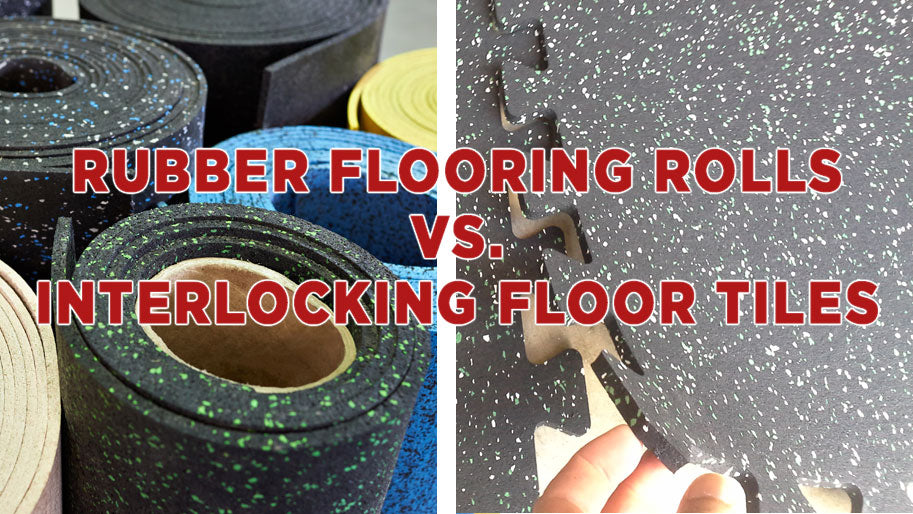You're looking to upgrade your gym by including that final critical piece, the flooring.
How do you know which type of rubber flooring to buy? Should you go with Rubber flooring rolls or with Interlocking floor tiles?
The easy answer is, it depends...
Rubber Flooring Rolls or Interlocking Floor Tiles?
Like paper bags vs. plastic (I think paper is making a comeback) and Batman vs. Superman (Batman won that one), there is really no right or wrong answer. It really does depend on some important questions you need to answer before choosing:
- Is your floor going to be a permanent installation or temporary?
- Will you be looking to move your floor, expand your floor or change your floor anytime in the immediate future?
- Do you prefer different color accents within your floor?
- Is this install taking place in a larger commercial facility or a smaller unused office or bedroom?
- Are you installing your rubber floor in your garage and plan to still drive your car into the garage occasionally?
Let’s go over the PROS & CONS of each.
Rubber Flooring Rolls - Pros

- Quicker to install in larger rooms, less trimming.
- Cost Effective
- Rolls are easier to “double up” in drop zones for extra protection.
- Less waste – custom roll lengths can reduce overage
Rubber Flooring Rolls - Cons

- Larger rolls are difficult to unload from a truck during the delivery and move around afterward.
- Need to be glued down or tape down. Garage installs must be glued down.
- Difficult to replace, change or remove.
Interlocking Floor Tiles - Pros

- Easy to replace damaged tiles.
- Easier delivery, even larger amounts can be offloaded from a truck by hand in smaller increments.
- Can mix colors for effect or definition.
- Smaller tiles are easier to install in small areas – no glue or tape needed.
- Can install over an underlayment to result in a thicker floor at a reduced price. 3/8” tiles over a 3/8” underlayment will yield a ¾” thick super floor.
- Easy to remove - (consider in rental apartments or multi-use areas).
Interlocking Floor Tiles - Cons
- More expensive than rolls.
- Tiles and tape down rolls will allow moisture underneath.
Final Conclusion & Recommendations

We have given you a lot to think about. Let me throw a few more tidbits at you.
No floor comes “made to fit “so you must get comfortable with the fact that you will need a sharp utility knife, a tape measure and a straight edge.
No big deal, remember to measure twice, cut once and your all set. Check out this YouTube video on how to install rubber flooring rolls or how to install interlocking floor tiles for more in-depth tips.
Installs are easiest when the room is empty and ready to receive the floor. “Side to Side”
Installs where you install half the room, move the equipment over, then install the other half involves more time and energy.
Always lay rolls in the same direction. Same with tiles, some tiles will have markings on the underside to help you install each tile in the same direction.
Always allow your material to acclimate for at least 24 hours. Rubber will expand and contract, so allowing the material to relax prior to installing will help.
If you have any questions feel free to leave a comment below and we will respond or feel free to contact our team at sales@Fitfloors.com or (855) 348-3566. You can also hit the Live Chat button to talk to us directly.
![]()



Comments
FAB FLOORINGS
Hi ,
Your post on "RUBBER FLOORING ROLLS VS. INTERLOCKING FLOOR TILES – WHICH ONE SHOULD YOU CHOOSE? " really helped me out. And it works.
So I just wanted to say: “Thank you!”.
Thanks again,
Fab Floorings India
April 26, 2022
Leave a comment